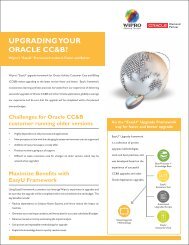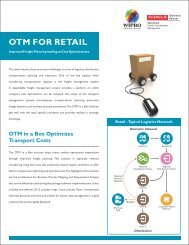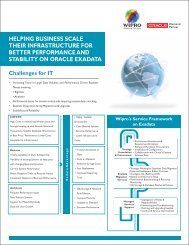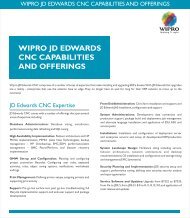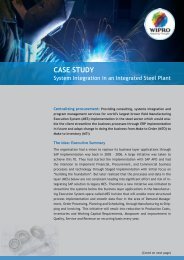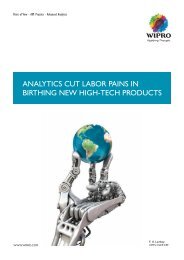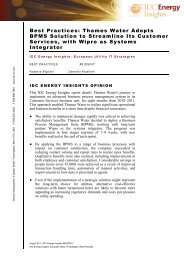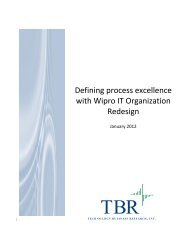Knowledge Management Strategies for Mitigating the Big Crew - Wipro
Knowledge Management Strategies for Mitigating the Big Crew - Wipro
Knowledge Management Strategies for Mitigating the Big Crew - Wipro
Create successful ePaper yourself
Turn your PDF publications into a flip-book with our unique Google optimized e-Paper software.
<strong>Knowledge</strong> <strong>Management</strong> <strong>Strategies</strong> <strong>for</strong> mitigating <strong>the</strong> <strong>Big</strong> <strong>Crew</strong> Change in E&P<br />
In <strong>Wipro</strong>’s implementation of wikis, <strong>the</strong>se elements are built into a much larger solution that links wikis to people, assets and<br />
processes, while using next generation search engines to quickly locate <strong>the</strong> in<strong>for</strong>mation needed to solve a problem or locate a<br />
person who has <strong>the</strong> required knowledge. The solution goes one step fur<strong>the</strong>r through communities and markets that greatly<br />
increase <strong>the</strong> knowledge pool. This will become critical as more and more knowledge leaves companies as people retire.<br />
<strong>Wipro</strong> has been studying this issue since 2007 and has worked with Rice University, Microsoft and customers <strong>for</strong>mally and<br />
in<strong>for</strong>mally. <strong>Wipro</strong> is a Silver sponsor of Rice’s Energy <strong>Management</strong> program. Since <strong>Wipro</strong> plans to base this solution on <strong>the</strong> MOSS<br />
plat<strong>for</strong>m, Microsoft has funded research and provided technical expertise. Many of <strong>Wipro</strong>’s customers have shared in<strong>for</strong>mation<br />
on <strong>the</strong>ir internal research programs. <strong>Wipro</strong> has provided a Proof-of-Concept (POC) to Petrobras in Houston, TX. Petrobras is<br />
[3]<br />
evaluating <strong>the</strong> POC’s ability to improve offshore operations in <strong>the</strong> Gulf of Mexico (GOM).<br />
The Challenge<br />
Most of <strong>the</strong> world’s “easy” oil is gone, <strong>for</strong>cing oil companies to focus on smaller oil fields, enhanced recovery, and deepwater oil.<br />
4All three are engineering intensive and require large capital investments. This is happening at a time when most of <strong>the</strong><br />
industry’s top engineering talent is about to retire. Making matters worse, universities are only providing a fraction of what is<br />
needed to replace <strong>the</strong> retirees. As a result, <strong>the</strong> oil industry is in a crisis.<br />
Twenty years ago <strong>the</strong>re were fifteen “Super Giant” oil fields capable of producing a million barrels per day. Today <strong>the</strong>re are only<br />
four.5 In order to meet production targets, companies are producing larger numbers of smaller fields. These smaller fields are<br />
resource-intensive, requiring substantially more engineering hours per barrel of oil produced. Smaller fields also scatter<br />
engineers, reducing productivity. Since it is unlikely that new Super Giant fields will be discovered, smaller fields will<br />
produce more and more of <strong>the</strong> world’s oil. As a result, <strong>the</strong> demand <strong>for</strong> petroleum engineers will increase year after year unless<br />
technology can be used to offset this trend.<br />
Since low-cost oil is becoming harder and harder to find, <strong>the</strong> industry is revisiting depleted oil fields with enhanced recovery<br />
technologies such as gas injection, chemical injection, ultrasonic stimulation, microbial recovery and <strong>the</strong>rmal recovery. In a<br />
typical field only 20% to 40% of <strong>the</strong> oil can be produced by primary and secondary recovery means. With enhanced recovery this<br />
improves to 30% to 60%. The downside is <strong>the</strong> expense and <strong>the</strong> fact that it is engineering intensive. As energy prices increase,<br />
enhanced recovery makes economic sense. However, it will also fur<strong>the</strong>r strain engineering resources.<br />
Seven of <strong>the</strong> last 10 Giant oil fields have been discovered in deep water off Brazil, in <strong>the</strong> Gulf of Mexico and in <strong>the</strong> Persian Gulf.<br />
Giant oil fields are capable of producing more than 100,000 barrels of oil per day or 10 percent of a Super Giant. For example,<br />
BP’s Thunderhorse plat<strong>for</strong>m 150 miles sou<strong>the</strong>ast of New Orleans in <strong>the</strong> Gulf of Mexico now produces between 100,000 and<br />
300,000 barrels of oil. It came on line with seven wells in 20086. Future production may hit as much as a million barrels of oil per<br />
day from up to 50 wells. The semi-submersible plat<strong>for</strong>m cost over $1 billion dollars to build and accounts <strong>for</strong> 3.3% of current U.S.<br />
oil production. Thunderhorse was originally planned to come on line in 2005 and ran three years behind schedule. It is widely<br />
believed that a shortage of engineering talent contributed to <strong>the</strong> delay. Since <strong>the</strong>re are likely few Giants and Super Giants left to<br />
be found on shore, <strong>the</strong> future of oil production will move off shore. This will fur<strong>the</strong>r stress <strong>the</strong> short supply of engineering staff.<br />
5 | www.wipro.com/industryresearch<br />
WIPRO TECHNOLOGIES




